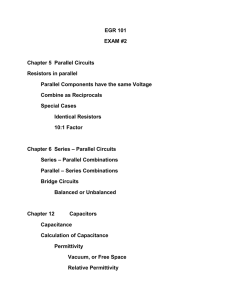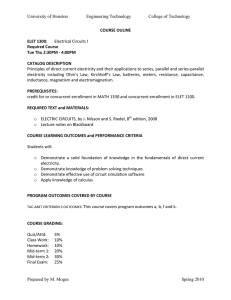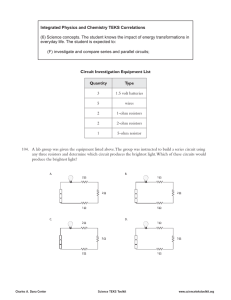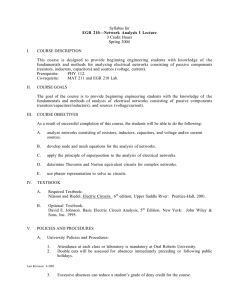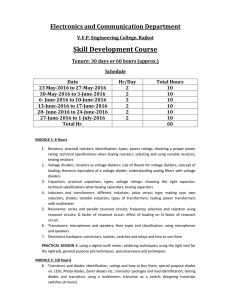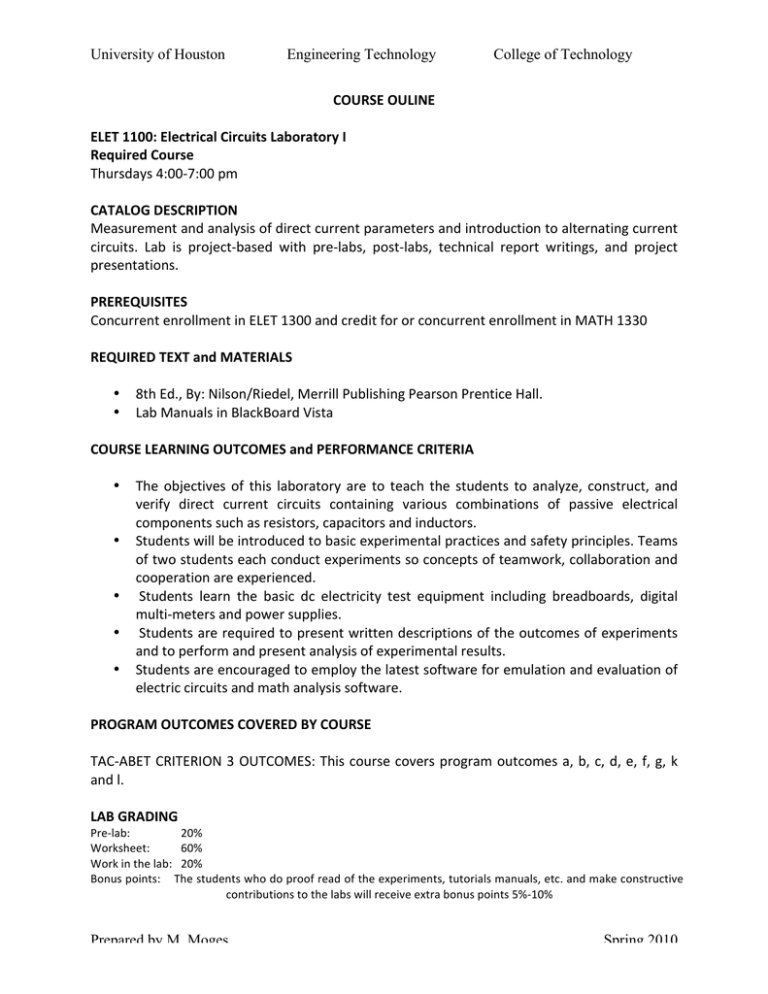
University of Houston
Engineering Technology
College of Technology
COURSE OULINE ELET 1100: Electrical Circuits Laboratory I Required Course Thursdays 4:00-­‐7:00 pm CATALOG DESCRIPTION Measurement and analysis of direct current parameters and introduction to alternating current circuits. Lab is project-­‐based with pre-­‐labs, post-­‐labs, technical report writings, and project presentations. PREREQUISITES Concurrent enrollment in ELET 1300 and credit for or concurrent enrollment in MATH 1330 REQUIRED TEXT and MATERIALS • 8th Ed., By: Nilson/Riedel, Merrill Publishing Pearson Prentice Hall. • Lab Manuals in BlackBoard Vista COURSE LEARNING OUTCOMES and PERFORMANCE CRITERIA • The objectives of this laboratory are to teach the students to analyze, construct, and verify direct current circuits containing various combinations of passive electrical components such as resistors, capacitors and inductors. • Students will be introduced to basic experimental practices and safety principles. Teams of two students each conduct experiments so concepts of teamwork, collaboration and cooperation are experienced. • Students learn the basic dc electricity test equipment including breadboards, digital multi-­‐meters and power supplies. • Students are required to present written descriptions of the outcomes of experiments and to perform and present analysis of experimental results. • Students are encouraged to employ the latest software for emulation and evaluation of electric circuits and math analysis software. PROGRAM OUTCOMES COVERED BY COURSE TAC-­‐ABET CRITERION 3 OUTCOMES: This course covers program outcomes a, b, c, d, e, f, g, k and l. LAB GRADING Pre-­‐lab: 20% Worksheet: 60% Work in the lab: 20% Bonus points: The students who do proof read of the experiments, tutorials manuals, etc. and make constructive contributions to the labs will receive extra bonus points 5%-­‐10% Prepared by M. Moges
Spring 2010
University of Houston
Engineering Technology
College of Technology
Attendance: Attendance at every lab session is mandatory. Absences will be recorded and will reflect on your grade. EXPERIMENTS TO PERFORM: Laboratory procedures, including tools like C-­‐maps, Pspice and laboratory equipment 1. Coverage of resistors and the resistor color code. Use and properties of the digital multi-­‐
meter for measuring resistance and capacitance. Concept of current, voltage and resistor. 2. Properties of resistors in series. Basic concepts of AC and DC, oscilloscope and function generator principles. Pspice introduction. 3. Power, power dissipation, Verification of Kirchhoff’s Voltage Law (KVL) and the voltage divider, Ohm’s law. 4. Identification of resistors in parallel. Verification of Kirchhoff’s Current Law (KCL) and the current divider. Series and parallel resistance and their equivalent capacitor circuits. 5. Study of resistors in complex series-­‐parallel combinations. Validation of the Superposition Theorem. Verification of the Wheatstone Bridge Circuit. Introduction to AC voltage and current. 6. Principle of maximum power transfer, Thevenin’s theorem, Reactance concepts and Delta-­‐Y conversions. 7. Verification of inductor properties in dc circuits. Transient response of R-­‐L and R-­‐L-­‐C circuits passive filters. Three-­‐way crossover network (Speaker) 8. Applications of RLC circuits: Resonance and LC tuned filters and tuned amplifiers. 9. DC power supply project. Successful completion of this course fulfills the technical content curricular requirements for the degree plan in Computer Engineering Technology. Prepared by M. Moges
Spring 2010

